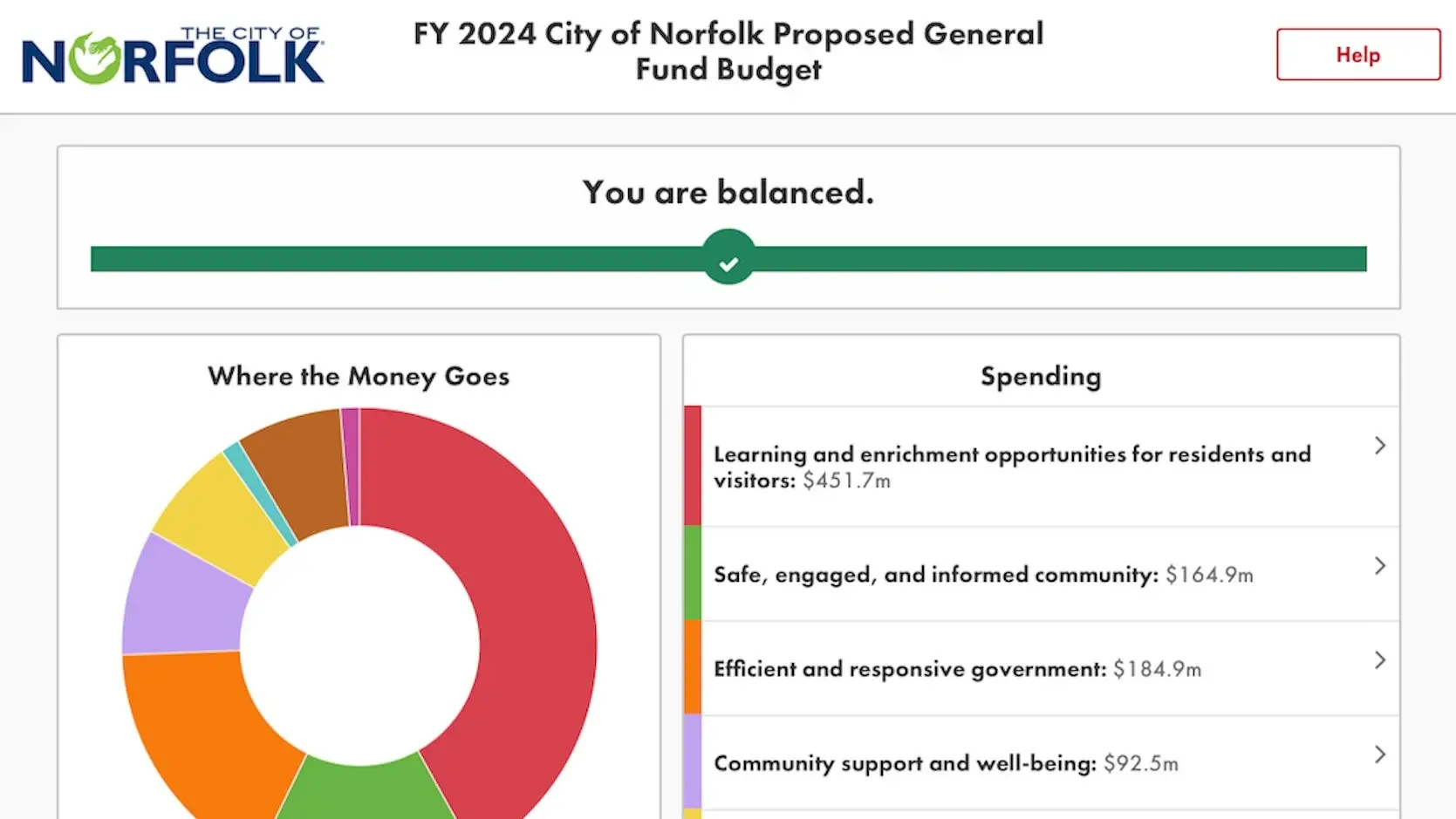Norfolk’s Budget Engagement Increases Resident Understanding of the “Delicate Reality of Allocating Funding”
By Polco on October 2, 2023

How the city of Norfolk is updating its budgeting process to achieve its strategic goals.
Since 2018, the City of Norfolk, Virginia, has consistently provided opportunities for its residents to use interactive, online simulation tools to gain understanding of the budget and its impact on their community. Now, the city is taking another innovative step: shifting away from traditional line-item budgeting toward a budget process organized around programs, strategic priorities and outcomes. Such a move to program budgeting is a best practice and the way of the future, according to the Rethinking Budgeting initiative by the Government Finance Officers Association (GFOA).
The shift is evident in Norfolk’s FY 2024 Proposed General Fund Budget simulation, which was built using Balancing Act from Polco’s Budget Simulation tool. The simulation ties the city’s budget to its strategic priorities — the big-picture goals of the community. Connecting spending levels to these goals provides yet another layer of contextual information to budget engagement opportunities for residents.
“Our simulation is currently organized by strategic objectives because of our move to program budgeting,” said Amanda Kostusiak, Senior Budget and Policy Analyst for Norfolk’s Office of Budget and Strategic Planning. “The services our programs offer citywide are all categorized into one of eight service objectives — from ‘Learning and Enrichment Opportunities’ to ‘Resilient Norfolk’ to ‘Safe, Informed, and Engaged Community.’ Using strategic objectives adds another layer to understanding how a department serves the community and the delicate reality of allocating funding.”
Norfolk’s efforts to align its budget to its strategic objectives demonstrates how local governments can implement new ways of thinking about the budgeting process and take advantage of advances in technology to build caring and resilient communities and reverse declining trust in government. This kind of approach is outlined in “A Roadmap for Real Collaboration in Budgeting,” a white paper developed by government technology companies Balancing Act from Polco, Envisio and Euna Solutions to introduce an integrated and iterative process to align communities with their governments.

When Every Day is a Budget Engagement Day
Historically local governments have relied on a budget process that favors addressing short-term priorities over long-range planning. But in 2018, Norfolk started moving away from incremental processes and into a more integrated approach. At the time, Norfolk faced a budget challenge: the city’s revenue growth wasn’t keeping pace with its expenses, causing a $13.3 million budget deficit going into 2019. City leaders had to cut costs or raise revenues and wanted residents to understand the reality of their budget challenge.
It was also apparent that the traditional method of community outreach around the budget wasn’t cutting it. The city was spending immense amounts of staff time to engage small crowds of the usual suspects. It needed better feedback from residents to make informed decisions.
Since that time, Norfolk’s budget engagement has become a year-round activity, with different emphases at different points in the budget process. Early in the fiscal year the city launches a simulation with a preliminary budget. This first version is based on gauging broad priorities and seeing how residents would resolve tough potential tradeoffs. The second version accompanies the city manager’s proposed budget so the public and elected officials can both see the rationale for initial decisions and provide high-level input.
In addition to asking residents to weigh in on how to best balance the budget, Norfolk has also used Balancing Act’s Taxpayer Receipt, a budget tool that shows residents how much of their tax bill goes towards different areas in the city like debt service, libraries, or recreation.
Balancing Act’s simulation tools help the city create more constructive, informative conversation about the budget and engage citizens in a process that is often lacking in transparency, Kostusiak said.
“The primary benefit we see as a city with Balancing Act is direct feedback by our citizens,” she said. “The simulations take a dense and dull subject and make it engaging, understandable and exciting. We also can begin to explain the connections to revenues and expenditures and the relationships of a balanced budget.”
It also enables resident input to be captured independently, where a resident can work on the simulation on their own, and allows for interacting in group settings, which the city does with civic leagues. “We are currently changing when we engage our residents with simulation,” Kostusiak said. “We are getting residents involved in the process sooner and we hope to see a continued growth in engagement and participation.”
ARPA Accountability During The Pandemic
Online public engagement evolved from a nice-to-have to need-to-have feature of government during the pandemic, and Norfolk’s effort with Balancing Act’s Prioritize tool represented an acceleration of online citizen engagement options that were informative but also easily accessible. Local news coverage highlighted the effort.

In 2022, Norfolk was one of the first local governments to use Prioritize for gathering input on priorities for its American Rescue Plan Act (ARPA) funds. Using this simulation, residents weighed in on the best uses for $154 million in ARPA funds.
The interactive tool gave residents a quick and simple way to provide input on 20 projects in its preliminary recommended investment plan and 7 general funding area focus projects. Those ranged from constructing a regional broadband ring ($6 million) to social safety net programming ($10 million) to providing gap financing for affordable housing ($6 million) to constructing a fishing pier ($1.5 million).

Users made their selections and then rank ordered them by drag-and-drop. With 6,069 page views, 888 submissions, and a 15% submission rate, the simulation represented a big win for the city’s engagement efforts. Ultimately, the city chose to allocate funds to a downtown floodwall project (the largest investment option at $64 million), continuity of services, neighborhood Capital Improvement Planning (CIP) projects, nonprofit assistance and broadband expansion.
Budget Engagement Expectations
It is safe to say Norfolk residents are now accustomed to simulation tools as part of the annual budgeting process, Kostusiak said. “We saw our highest numbers of participation during the engagement process in the plan for use of relief funding.”
Engagement has slowed a bit since then, but the city is looking at new strategies to boost participation, such as Budget and Brews, a casual “come talk about budget” event where residents can help balance the current budget and provide input on the upcoming process. The city also plans to tour the civic leagues and use the Meetings feature to capture input.
“Our residents love to provide input,” Kostusiak said, “and Balancing Act has become an annual part of capturing their voice.”
Learn more about Balancing Act from Polco's budget simulation tools by requesting a demo.
Related Articles
Popular posts
Sign-up for Updates
You May Also Like
These Related Stories

Lawrence Makes Innovative Use of Balancing Act Software to Educate and Engage Residents About Budget Trade-Offs

Flashback: How Hartford, CT Helped Launch a New Era of Budget Engagement

